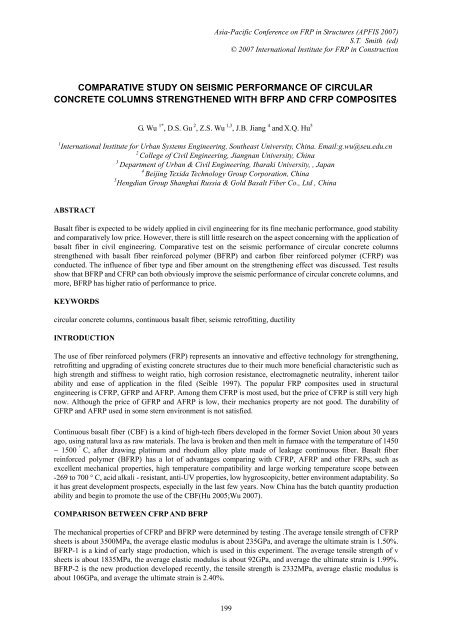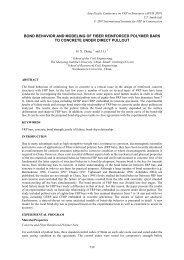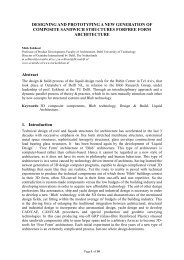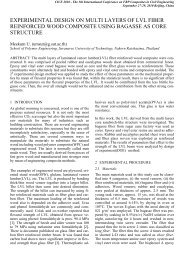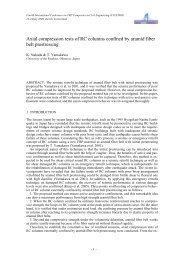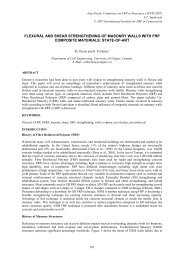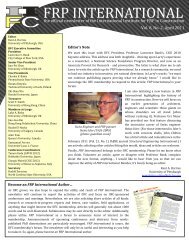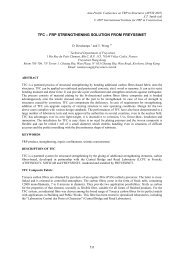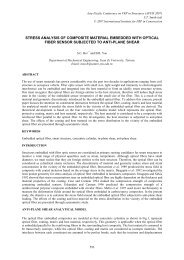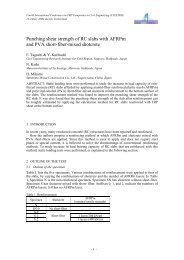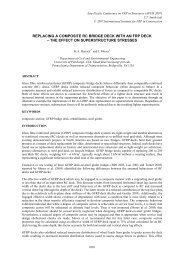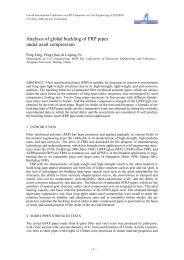comparative study on seismic performance of circular concrete ...
comparative study on seismic performance of circular concrete ...
comparative study on seismic performance of circular concrete ...
You also want an ePaper? Increase the reach of your titles
YUMPU automatically turns print PDFs into web optimized ePapers that Google loves.
Asia-Pacific C<strong>on</strong>ference <strong>on</strong> FRP in Structures (APFIS 2007)<br />
S.T. Smith (ed)<br />
© 2007 Internati<strong>on</strong>al Institute for FRP in C<strong>on</strong>structi<strong>on</strong><br />
COMPARATIVE STUDY ON SEISMIC PERFORMANCE OF CIRCULAR<br />
CONCRETE COLUMNS STRENGTHENED WITH BFRP AND CFRP COMPOSITES<br />
G. Wu 1* , D.S. Gu 2 , Z.S. Wu 1,3 , J.B. Jiang 4 and X.Q. Hu 5<br />
1 Internati<strong>on</strong>al Institute for Urban Systems Engineering, Southeast University, China. Email:g.wu@seu.edu.cn<br />
2<br />
College <strong>of</strong> Civil Engineering, Jiangnan University, China<br />
3<br />
Department <strong>of</strong> Urban & Civil Engineering, Ibaraki University, , Japan<br />
4<br />
Beijing Texida Technology Group Corporati<strong>on</strong>, China<br />
5 Hengdian Group Shanghai Russia & Gold Basalt Fiber Co., Ltd , China<br />
ABSTRACT<br />
Basalt fiber is expected to be widely applied in civil engineering for its fine mechanic <strong>performance</strong>, good stability<br />
and <str<strong>on</strong>g>comparative</str<strong>on</strong>g>ly low price. However, there is still little research <strong>on</strong> the aspect c<strong>on</strong>cerning with the applicati<strong>on</strong> <strong>of</strong><br />
basalt fiber in civil engineering. Comparative test <strong>on</strong> the <strong>seismic</strong> <strong>performance</strong> <strong>of</strong> <strong>circular</strong> c<strong>on</strong>crete columns<br />
strengthened with basalt fiber reinforced polymer (BFRP) and carb<strong>on</strong> fiber reinforced polymer (CFRP) was<br />
c<strong>on</strong>ducted. The influence <strong>of</strong> fiber type and fiber amount <strong>on</strong> the strengthening effect was discussed. Test results<br />
show that BFRP and CFRP can both obviously improve the <strong>seismic</strong> <strong>performance</strong> <strong>of</strong> <strong>circular</strong> c<strong>on</strong>crete columns, and<br />
more, BFRP has higher ratio <strong>of</strong> <strong>performance</strong> to price.<br />
KEYWORDS<br />
<strong>circular</strong> c<strong>on</strong>crete columns, c<strong>on</strong>tinuous basalt fiber, <strong>seismic</strong> retr<strong>of</strong>itting, ductility<br />
INTRODUCTION<br />
The use <strong>of</strong> fiber reinforced polymers (FRP) represents an innovative and effective technology for strengthening,<br />
retr<strong>of</strong>itting and upgrading <strong>of</strong> existing c<strong>on</strong>crete structures due to their much more beneficial characteristic such as<br />
high strength and stiffness to weight ratio, high corrosi<strong>on</strong> resistance, electromagnetic neutrality, inherent tailor<br />
ability and ease <strong>of</strong> applicati<strong>on</strong> in the filed (Seible 1997). The popular FRP composites used in structural<br />
engineering is CFRP, GFRP and AFRP. Am<strong>on</strong>g them CFRP is most used, but the price <strong>of</strong> CFRP is still very high<br />
now. Although the price <strong>of</strong> GFRP and AFRP is low, their mechanics property are not good. The durability <strong>of</strong><br />
GFRP and AFRP used in some stern envir<strong>on</strong>ment is not satisfied.<br />
C<strong>on</strong>tinuous basalt fiber (CBF) is a kind <strong>of</strong> high-tech fibers developed in the former Soviet Uni<strong>on</strong> about 30 years<br />
ago, using natural lava as raw materials. The lava is broken and then melt in furnace with the temperature <strong>of</strong> 1450<br />
~ 1500 ° C, after drawing platinum and rhodium alloy plate made <strong>of</strong> leakage c<strong>on</strong>tinuous fiber. Basalt fiber<br />
reinforced polymer (BFRP) has a lot <strong>of</strong> advantages comparing with CFRP, AFRP and other FRPs, such as<br />
excellent mechanical properties, high temperature compatibility and large working temperature scope between<br />
-269 to 700 ° C, acid alkali - resistant, anti-UV properties, low hygroscopicity, better envir<strong>on</strong>ment adaptability. So<br />
it has great development prospects, especially in the last few years. Now China has the batch quantity producti<strong>on</strong><br />
ability and begin to promote the use <strong>of</strong> the CBF(Hu 2005;Wu 2007).<br />
COMPARISON BETWEEN CFRP AND BFRP<br />
The mechanical properties <strong>of</strong> CFRP and BFRP were determined by testing .The average tensile strength <strong>of</strong> CFRP<br />
sheets is about 3500MPa, the average elastic modulus is about 235GPa, and average the ultimate strain is 1.50%.<br />
BFRP-1 is a kind <strong>of</strong> early stage producti<strong>on</strong>, which is used in this experiment. The average tensile strength <strong>of</strong> v<br />
sheets is about 1835MPa, the average elastic modulus is about 92GPa, and average the ultimate strain is 1.99%.<br />
BFRP-2 is the new producti<strong>on</strong> developed recently, the tensile strength is 2332MPa, average elastic modulus is<br />
about 106GPa, and average the ultimate strain is 2.40%.<br />
199
The elastic modulus <strong>of</strong> CFRP is higher than that <strong>of</strong> BFRP, which is an advantage in flexural retr<strong>of</strong>itting RC beams.<br />
But the ultimate strain <strong>of</strong> BFRP is higher than that <strong>of</strong> CFRP, this advantage can be regarded in RC columns<br />
retr<strong>of</strong>itting to enhance the <strong>seismic</strong> <strong>performance</strong>. This paper is focused <strong>on</strong> investigating the effectiveness and<br />
efficiency <strong>of</strong> improving the <strong>seismic</strong> <strong>performance</strong> <strong>of</strong> RC columns strengthened with BFRP and CFRP composites.<br />
EXPERIMENTAL PROGRAM<br />
Four large-scale reinforced c<strong>on</strong>crete columns were c<strong>on</strong>structed and tested to investigate the retr<strong>of</strong>it effectiveness<br />
<strong>of</strong> the FRP jacketing systems. As shown in Fig.1, the 1000mm-tall and 360mm-diameter model columns were<br />
reinforced with 12 deformed No.25(nominal diameter=25mm, yield stress is 382MPa obtained from tensile<br />
coup<strong>on</strong> tests) bars that c<strong>on</strong>stituted a l<strong>on</strong>gitudinal steel ratio <strong>of</strong> 5.8% <strong>of</strong> the gross area <strong>of</strong> column secti<strong>on</strong>. Round<br />
No.6(diameter=6.5mm, yield stress is 320MPa obtained from tensile coup<strong>on</strong> tests) hoops spaced at 150 mm were<br />
used as transverse reinforcement. The average strength <strong>of</strong> c<strong>on</strong>crete was 34.9MPa by the test <strong>of</strong> cylinders made at<br />
the same time with columns. The axial load was 1200kN. The regi<strong>on</strong> <strong>of</strong> 100mm from the stub face was<br />
strengthened with additi<strong>on</strong>al eight D25mm bars, and the D10mm ties were placed at a spacing <strong>of</strong> 30 mm within<br />
this regi<strong>on</strong> to minimize the chances <strong>of</strong> failure at the secti<strong>on</strong> <strong>of</strong> the stub face(Gu 2006). All the specimens were<br />
tested under c<strong>on</strong>stant axial load and cyclic lateral excursi<strong>on</strong>s simulating <strong>seismic</strong> loading c<strong>on</strong>diti<strong>on</strong>s, as shown in<br />
Fig.2 . Descripti<strong>on</strong> <strong>of</strong> test specimens is shown in talbe 1.<br />
B-B<br />
B<br />
E<br />
B<br />
E<br />
Figure1. Reinforcement <strong>of</strong> columns<br />
Figure 2, Test set-up<br />
Table 1. Descripti<strong>on</strong> <strong>of</strong> test specimens<br />
Speicmen<br />
FRP Thickness <strong>of</strong> Axial load Axial load Aspect Character value <strong>of</strong><br />
treatment FRP(mm) (kN) ratio atio<br />
FRP<br />
CL0 As built - 1200 0.39 1.94 0<br />
CL1 1.0 CFRP 0.167 1200 0.39 1.94 0.217<br />
CL2 4.5CFRP 0.752 1200 0.39 1.94 0.977<br />
CL3 BFRP 2.0 1200 0.39 1.94 1.212<br />
One <strong>of</strong> these four specimens was used as c<strong>on</strong>trol column. Two columns was wrapped with CFRP, One was<br />
wrapped with 1 layer <strong>of</strong> CFRP composite straps, and the other was wrapped with 4.5 layer <strong>of</strong> CFRP composite<br />
straps. The forth specimen was wrapped with 12 layers <strong>of</strong> CBF fiber composite. The total thickness <strong>of</strong> CBF is<br />
2mm. The thickness <strong>of</strong> CBF is determined according to the same c<strong>on</strong>fined stiffness (Wu 2006) with the 4.5 layer<br />
<strong>of</strong> CFRP. As the strap was wrapped around the column, epoxy was applied to the surface and the multiple layers<br />
<strong>of</strong> the strap were adhered together to from a single composite wrap with the desired thickness. The main object <strong>of</strong><br />
this experiment is to <str<strong>on</strong>g>study</str<strong>on</strong>g> the <strong>seismic</strong> <strong>performance</strong> <strong>of</strong> RC <strong>circular</strong> columns retr<strong>of</strong>itted with different FRPs.<br />
A hydraulic jack with a capacity <strong>of</strong> 3000kN was used to apply the axial load that was measured by a load cell. The<br />
cyclic lateral load was applied by an actuator with a 1000kN load capacity and a 200 mm stroke capacity. The load<br />
cycles were divided into two phases: load c<strong>on</strong>trol and displacement c<strong>on</strong>trol. Load c<strong>on</strong>trol phase was used up to<br />
yielding <strong>of</strong> the l<strong>on</strong>gitudinal bars, bey<strong>on</strong>d that point, a displacement c<strong>on</strong>trol load sequence was used. The lateral<br />
load sequence c<strong>on</strong>sisted <strong>of</strong> three cycles each to Δ y , 2Δ y , 3Δ y ... and so <strong>on</strong>, until the specimen was unable to<br />
maintain the applied lateral load. Deflecti<strong>on</strong> Δ y was defined according to the method advised by Xiao, 1999. The<br />
displacement ductility μ is difined as the ratio <strong>of</strong> displacement to the yield displacement Δ y.<br />
APFIS 2007 200
RESULTS AND DISCUSSION<br />
Load-versus-displacement Resp<strong>on</strong>se<br />
The test results are shown in Table 2. The ultimate displacement is the displacement when the columns failed or<br />
the displacement corresp<strong>on</strong>ding to the lateral load which dropped 85% to the maximum load. The drift ratio is<br />
the ratio <strong>of</strong> ultimate displacement to the column height. The result listed in the table is the average value in the<br />
push and pull loading cycles. Plots <strong>of</strong> the lateral load-versus-displacement for the specimens are shown in Fig.3.<br />
Specimen<br />
Table.2 Test results<br />
Maximum lateral load(kN) Lateral displacement(mm)<br />
Maximum load Improvement Ultimate displacement Drift ratio<br />
CL-0 425 - 7.0 0.010<br />
CL1-1.0C 568 33.2% 18.0 0.022<br />
CL2-4.5C 680 59.9% 56.9 0.071<br />
CL3- BF 669 57.3% 57.4 0.072<br />
Fig.3(a) shows hysteresis loops for CL0 exhibiting a brittle shear failure mode. As is apparent from hysteresis<br />
loops, strength and stiffness degradati<strong>on</strong> is particularly severe. Fig.3(b) shows hysteresis loops for CL1<br />
exhibiting a shear failure mode with limited ductility. It can be found that in the Fig.3(c) (d) that stable flexural<br />
hysteresis loops with peak lateral loads exceeds the shear force corresp<strong>on</strong>ding to the ideal flexural strength <strong>of</strong> the<br />
retr<strong>of</strong>itted secti<strong>on</strong>. In further loading, suddenly degradati<strong>on</strong> in strength and stiffness occurred. Diag<strong>on</strong>al cracks at<br />
the sides <strong>of</strong> the units caused loss <strong>of</strong> aggregate interlock capacity <strong>of</strong> c<strong>on</strong>crete. The reducti<strong>on</strong> in the strength <strong>of</strong> the<br />
c<strong>on</strong>crete shear resisting mechanisms caused a demand for further c<strong>on</strong>tributi<strong>on</strong> from CFRP, which could not be<br />
provided because the amount <strong>of</strong> CFRP used is not enough. Coupled with this, the CFRP ruptured at the sides <strong>of</strong><br />
the unit, and then the specimen suffered shear failure. Inverse to CL1, CL2 and CL3 produced a fully ductile<br />
resp<strong>on</strong>se. The enough FRP used in these two specimens can provide the shear strength loss in c<strong>on</strong>crete. Local<br />
FRP ruptured within the plastic hinge regi<strong>on</strong> was noted in the experiment. At the last, FRP can not provide<br />
enough c<strong>on</strong>finement to the c<strong>on</strong>crete in the hinge regi<strong>on</strong>, and subsequently the specimens failed. Comparis<strong>on</strong> <strong>of</strong><br />
hysteresis loops <strong>of</strong> CL2 and CL3 shows that CFRP and BFRP both can improve the <strong>seismic</strong> <strong>performance</strong> <strong>of</strong> RC<br />
<strong>circular</strong> columns efficiently.<br />
Jacket Strain Resp<strong>on</strong>se<br />
Strain gauges were mounted <strong>on</strong> the composite al<strong>on</strong>g its circumferential directi<strong>on</strong> during testing. In the four<br />
directi<strong>on</strong>s, from 150 mm above the base, four strain gauges were mounted every <strong>on</strong>e 50mm.<br />
Fig. 4 shows the strain distributi<strong>on</strong>s <strong>of</strong> CL2 al<strong>on</strong>g the column height <strong>on</strong> the face parallel to the loading directi<strong>on</strong><br />
corresp<strong>on</strong>ding to the push displacement at peak. As shown in the Fig.4, jacket strains increase significantly<br />
corresp<strong>on</strong>ding to the increased ductility levels. This indicates the increased engagement <strong>of</strong> shear resistance from<br />
the composite jacket following the decrease <strong>of</strong> shear resistance c<strong>on</strong>tributi<strong>on</strong>s <strong>of</strong> the original RC mechanisms. The<br />
larger strains near the column ends also implied the c<strong>on</strong>finement effect <strong>of</strong> the jacket <strong>on</strong> c<strong>on</strong>crete. Fig. 5 shows the<br />
strain at the middle height <strong>on</strong> specimen CL3 according to the displacement. When the displacement comes to zero,<br />
the residual strain increases significantly corresp<strong>on</strong>ding to the increased displacement. Fig. 6 shows the strain<br />
distributi<strong>on</strong>s <strong>of</strong> CL1 and CL2 al<strong>on</strong>g the column height <strong>on</strong> the face parallel to the loading directi<strong>on</strong> corresp<strong>on</strong>ding to<br />
the push displacement equals 18mm. As can be seen in the Fig.6, the column which suffered ductile shear failure,<br />
such as CL1, the strain at the middle porti<strong>on</strong> is significantly large than the strain at the lower porti<strong>on</strong> <strong>of</strong> the column,<br />
and the FRP firstly ruptured at the middle porti<strong>on</strong>.<br />
APFIS 2007 201
600<br />
400<br />
600<br />
400<br />
P max<br />
=562.1<br />
Lateral load(kN)<br />
200<br />
0<br />
-200<br />
Lateral load(kN)<br />
200<br />
0<br />
-200<br />
-400<br />
-400<br />
-600<br />
-600<br />
P max<br />
=573.8<br />
-30 -20 -10 0 10 20 30<br />
Displacement(mm)<br />
-30 -20 -10 0 10 20 30<br />
Displacement(mm)<br />
(a) CL-0<br />
(b) CL1-1.0CFRP<br />
800<br />
800<br />
600<br />
600<br />
400<br />
400<br />
Lateral load(kN)<br />
200<br />
0<br />
-200<br />
-400<br />
Lateral load(kN)<br />
200<br />
0<br />
-200<br />
-400<br />
-600<br />
-600<br />
-800<br />
-60 -40 -20 0 20 40 60<br />
Displacement(mm)<br />
-800<br />
-60 -40 -20 0 20 40 60<br />
Displacement(mm)<br />
(c) CL2-4.5CFRP<br />
(d)CL3-BFRP<br />
Figure 3. Load-versus-displacement resp<strong>on</strong>se<br />
Fig 7 shows the relati<strong>on</strong>ship <strong>of</strong> the average strain <strong>of</strong> the three gauges at the middle porti<strong>on</strong> <strong>of</strong> the column <strong>on</strong> the<br />
face parallel to the loading directi<strong>on</strong> at peak displacement in push. When the FRP used is not enough, such as CL1,<br />
FRP cannot provide enough shear strength to compensate the reducti<strong>on</strong> in the strength in the c<strong>on</strong>crete shear<br />
resisting mechanisms. So the strain increased significantly corresp<strong>on</strong>ding to the increased displacement. To avoid<br />
this type <strong>of</strong> failure, more FRP is needed. The added FRP can bear the shear force directly, and also it can provide<br />
efficient c<strong>on</strong>finement to c<strong>on</strong>crete to prevent the loss <strong>of</strong> aggregate interlock capacity <strong>of</strong> c<strong>on</strong>crete. As can be seen in<br />
the Fig.7, when the FRP is added, the strain increases slowly with the increased displacement. This relati<strong>on</strong>ship <strong>of</strong><br />
specimen CL3 which is retr<strong>of</strong>itted with BFRP is very similar to the specimen CL2 retr<strong>of</strong>itted with 4.5 lays <strong>of</strong><br />
CFRP.<br />
Strain gauage positi<strong>on</strong>(mm)<br />
300<br />
250<br />
200<br />
150<br />
u=1<br />
u=3<br />
u=5 u=7<br />
u=9<br />
u=11<br />
Displacement(mm)<br />
0 2000 4000 6000 8000 10000<br />
Strain(με)<br />
Figure 4. Strain resp<strong>on</strong>se <strong>of</strong> south face <strong>of</strong> CL2<br />
Figure 5. Strain resp<strong>on</strong>se <strong>of</strong> gauge F16 in CL3<br />
APFIS 2007 202
The retr<strong>of</strong>itted columns can have the same or even better <strong>performance</strong> than the columns retr<strong>of</strong>itted with CFRP.<br />
C<strong>on</strong>sidering the low price <strong>of</strong> basalt fiber, it is believed that c<strong>on</strong>tinuous basalt fiber can have a good prospect in<br />
<strong>seismic</strong> retr<strong>of</strong>itting <strong>of</strong> RC columns.<br />
ACKNOWLEDGEMENT<br />
The authors would like to acknowledge financial support from the Nati<strong>on</strong>al Natural Science Foundati<strong>on</strong> <strong>of</strong> China<br />
under grant number 50608015, the Nati<strong>on</strong>al Basic Research Program <strong>of</strong> China (973 Program, No.<br />
2007CB714200), the Natural Science Foundati<strong>on</strong> <strong>of</strong> Jiangsu Province in China (BK2006554). Supplementary<br />
support was provided by the Scientific Research Foundati<strong>on</strong> <strong>of</strong> the Qing Hai Science & Technology Department<br />
<strong>of</strong> China.<br />
REFERENCES<br />
Gu,D.S. and Wu, G. (2006). “Experimental <str<strong>on</strong>g>study</str<strong>on</strong>g> <strong>on</strong> <strong>seismic</strong> <strong>performance</strong> <strong>of</strong> RC short <strong>circular</strong> columns<br />
strengthened with CFRP composites under high level compressi<strong>on</strong>”, Earthquake Resistant Engineering and<br />
Retr<strong>of</strong>itting, 28(6),71-77.(In Chinese)<br />
Hu, X.Q. and Shen,T,N. (2005). “The applicati<strong>on</strong>s <strong>of</strong> the CBF in war industry & civil fields ”, Hi-Tech Fiber &<br />
Applicati<strong>on</strong>,30(6) ,7-13 (In Chinese)<br />
Seible, F., M.J.N.Priestley, G.A.Hegemier and D. Innamorato (1997). “Seismic retr<strong>of</strong>it <strong>of</strong> RC columns with<br />
c<strong>on</strong>tinuous carb<strong>on</strong> fiber jackets”, Journal <strong>of</strong> composites for c<strong>on</strong>structi<strong>on</strong>. 1(2),52-62<br />
Wu,G. and Lu, Z.T. (2006). “Strength and ductility <strong>of</strong> c<strong>on</strong>crete cylinders c<strong>on</strong>fined with FRP composites”,<br />
C<strong>on</strong>structi<strong>on</strong> and Building Materials ,20 ,134–148<br />
Wu,G. and Wei,Y. (2007). “Comparative <str<strong>on</strong>g>study</str<strong>on</strong>g> <strong>on</strong> <strong>seismic</strong> <strong>performance</strong> <strong>of</strong> rectangular c<strong>on</strong>crete columns<br />
strengthened with BFRP and CFRP composites”, Industrial C<strong>on</strong>structi<strong>on</strong>, 37(6),14-18(In Chinese)<br />
Xiao, Y., Wu, H. and Martin, G. R. (1999). “Prefabricated Composite Jacketing <strong>of</strong> RC Jolumns for Enhanced<br />
Shear Strength”,Journal <strong>of</strong> Structural Engineering, 125(3):255-264<br />
APFIS 2007 204


